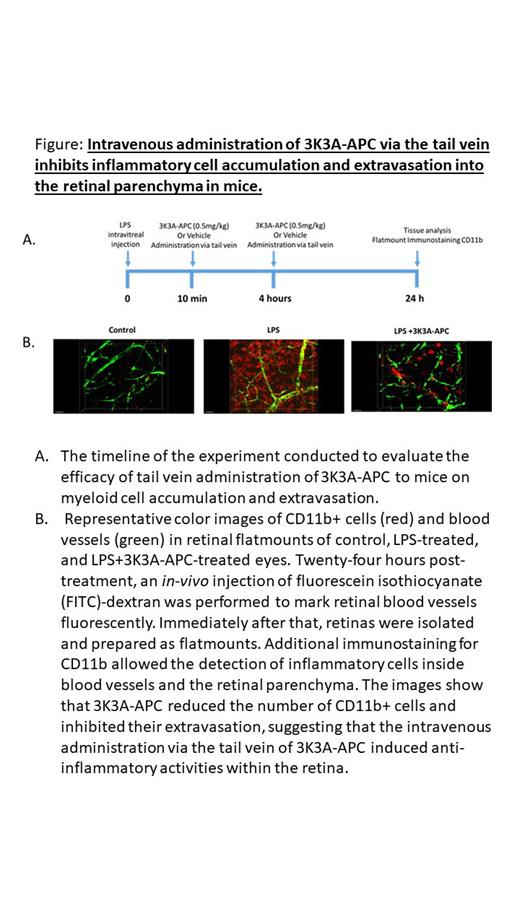Introduction: Choroidal neovascularization (CNV) is characterized by the growth of newly formed abnormal blood vessels from the choroid extending into the neurosensory retina, leading to vision loss. CNV is a common cause of visual impairment in neovascular age-related macular degeneration (nAMD) patients. Current treatments failed to stop the continuity of the neurodegenerative process. Despite the urgency, no neuroprotective agent has been found yet to treat AMD and other neurodegenerative ocular diseases.
3K3A-activated protein C (APC) is a cell-signaling analog of the endogenous blood serine protease APC. Preclinical studies showed that circulating plasma 3K3A-APC readily crosses the blood-brain barrier (BBB) and reaches neurons due to EPCR-dependent transport. In rodent models of stroke, brain injury, and neurodegenerative disorders, 3K3A-APC exerts neuroprotective, anti-inflammatory, and vasculoprotective activities. Due to its pleiotropic effects, 3K3A-APC has advanced to clinical trial stages for treating acute brain damage and chronic neurodegenerative diseases, which share similarities with retinal neurodegenerative disorders. Notably, the retina is part of the central nervous system (CNS), and the blood-retina barrier shares functional and structural similarities with the BBB.
We previously demonstrated that intraocular administration of 3K3A-APC functions as a pleiotropic cytoprotective molecule within the retina, reducing ocular inflammation, suppressing CNV growth, and exhibiting promising therapeutic potential as a neuroprotective agent for treating ocular disorders. Intraocular administration is commonly utilized for delivering therapeutics to treat retinal conditions. However, safety concerns, the burden on the healthcare system, and patient comfort may indicate that systemic administration of 3K3A-APC is a beneficial alternative.
Aim: To determine whether intravenously injecting 3K3A-APC into mice tails will cross the blood-retina barrier, induce anti-inflammatory activities in the retina, and suppress CNV.
Methods: The efficacy of systemic administration of 3K3A-APC was evaluated using two C57BL/6J murine models: the LPS-induced ocular inflammation and the laser-induced CNV model. CNV was triggered by laser and ocular inflammation was triggered by intravitreal injection of lipopolysaccharide (LPS). Murine recombinant 3K3A-APC was administered systemically via tail injection. Fluorescein isothiocyanate (FITC)-dextran perfusion followed by retinal flatmount staining with anti-CD11b was used to assess inflammatory co-localization of cells to retinal vessels. FITC-dextran perfusion followed by retinal pigment epithelium (RPE)-choroid flatmount was used to assess CNV vascular penetration using 3D confocal imaging.
Results: LPS injection triggered robust inflammatory cell infiltration in both the anterior and posterior chambers of the eyes. Systemic administration of 3K3A-APC (0.5 mg/kg, 1 and 4 hours post-LPS) significantly inhibited ocular inflammation. Immunostaining performed 24 hours post LPS revealed that 3K3A-APC reduced the number of CD11b+ monocyte and their extravasation into the retinal parenchyma (Figure). In the laser-induced CNV model, systemic administration of 0.2 mg/kg 3K3A-APC was applied one hour and four days post-laser. Evaluation of retinal specimens ten days post-laser showed that 3K3A-APC treatment significantly suppressed CNV growth, attenuated the abnormal growth of blood vessels from the choroid into the sensory retina, and decreased myeloid cell recruitment to the RPE-choroid area.
Conclusion: Our study reveals that systemically administered 3K3A-APC effectively inhibits ocular inflammation and reduces CNV formation. Drawing insights from the neuroprotective activities of 3K3A-APC in the brain and CNS and recognizing the retina, particularly the macula, as an extension of the brain, we propose 3K3A-APC as a potential neuroprotective treatment for AMD and other neurodegenerative retinal pathologies. Given the established safety of systemic 3K3A-APC administration in phase 2 clinical trials for ischemic stroke, our findings support further exploring 3K3A-APC as a novel therapeutic approach in ophthalmology. Further research is warranted to elucidate fully the mechanisms underlying 3K3A-APC's beneficial effects on the retina.
Disclosures
Livnat:MOR LTD-owned patents: Patents & Royalties: a co-inventor for Mor LTD-owned patents related to some studies in this Abstract. Nisgav:Mor LTD-owned patents: Patents & Royalties: a co-inventor for Mor LTD-owned patents related to some studies in this Abstract.. Levy-Mendelovich:Novo nordisk: Honoraria, Research Funding; Pfizer: Honoraria, Research Funding; Roch LTD: Honoraria. Weinberger:Mor LTD-owned patents: Patents & Royalties: a co-inventor for Mor LTD-owned patents related to some studies in this Abstract.. Kenet:Roch LTD: Honoraria; pfizer, Anlyam, BPL, Bayer, Okpo, Pfizer, Shire , Roche: Honoraria, Research Funding. Griffin:Scripps-owned patents: Patents & Royalties: a co-inventor for Scripps-owned patents related to some studies in this Abstract..


This feature is available to Subscribers Only
Sign In or Create an Account Close Modal